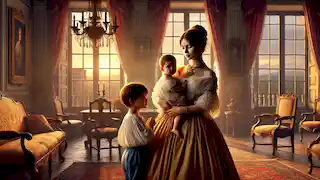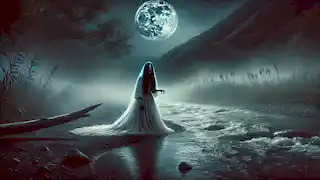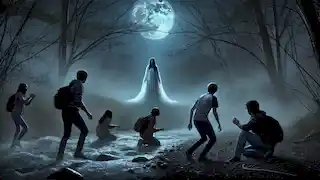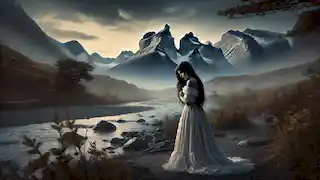In the misty highlands of Argentina, where the wind whispers through the valleys and the rivers carve their ancient paths through the mountains, there exists a tale as old as time itself—a tale of sorrow, love, and the eternal lament of a grieving mother. This is the story of La Llorona, the weeping woman, whose cries have echoed through the ages, haunting the dreams of those who dare to listen. The story begins in a small village nestled between the Andes mountains, where the people lived simple lives, their days filled with the toil of the earth and their nights with the warmth of family and tradition. It was here that a young woman named Maria was born, the daughter of humble farmers. Maria was known throughout the village for her beauty, a beauty that seemed to capture the very essence of the land—wild, untamed, and breathtakingly pure. Maria grew up as any other child in the village, learning the ways of the land, helping her parents in the fields, and dreaming of the future. But as she grew older, it became clear that her beauty was not just a passing trait but something extraordinary, something that drew the attention of everyone who laid eyes on her. As a young woman, Maria was courted by many men from the village, all eager to win her heart. Yet, Maria was not easily swayed. She had dreams of her own—dreams of a love that would sweep her off her feet, a love that would take her far beyond the boundaries of her village. It was this dream that led her to make a fateful decision, one that would change her life forever. One day, as the sun set behind the mountains, casting a golden hue over the village, a stranger arrived. He was a man of noble birth, his clothes fine and his manner sophisticated. He rode a black horse, its coat shimmering in the fading light, and as he dismounted, the villagers could not help but be drawn to him. The stranger introduced himself as Don Carlos, a wealthy landowner from a distant province, who had come to the village to oversee the expansion of his estates. Don Carlos was immediately taken with Maria, and she with him. His wealth and charm were unlike anything she had ever known, and soon, the two began to spend more and more time together. The villagers watched with bated breath as their relationship blossomed, for they knew that Maria was destined for greatness, but they feared what might come of this union with a man from beyond their world. Despite the warnings of her parents and the whispers of the villagers, Maria fell deeply in love with Don Carlos. He promised her the world—a life of luxury, far away from the toil of the fields and the constraints of village life. It was everything Maria had ever dreamed of, and so, when Don Carlos asked her to marry him, she agreed without hesitation. The wedding was a grand affair, with guests arriving from all over the region to celebrate the union of the beautiful Maria and the wealthy Don Carlos. The village was filled with music, laughter, and the smell of roasting meats as the festivities continued long into the night. Maria’s parents, though hesitant, could not help but be proud of their daughter, who had married into wealth and status beyond their wildest dreams. After the wedding, Maria moved with Don Carlos to his grand estate, a vast expanse of land far from the village. Here, she lived in luxury, surrounded by servants and riches. Yet, despite the wealth and comfort, Maria began to feel a growing sense of unease. Don Carlos, once so attentive and loving, began to grow distant. He would leave for days, sometimes weeks, to attend to business, leaving Maria alone in the vast, empty house. In time, Maria gave birth to two children, a boy and a girl, whom she loved more than anything in the world. Her children became her solace in Don Carlos’s absence, and she devoted herself entirely to their care. The villagers, who had once been envious of Maria’s good fortune, now whispered of her loneliness and isolation in the grand estate. As the years passed, Maria’s unease grew into a deep and gnawing fear. Don Carlos’s absences became longer, and when he did return, he was cold and distant, his affection for her seemingly gone. Maria suspected that he had found another woman, someone younger and more beautiful, someone who could give him the love and attention he no longer found in her. One day, Maria’s worst fears were confirmed. As she walked through the market in a nearby town, she saw Don Carlos with another woman, a woman who was indeed younger and more beautiful. They walked arm in arm, laughing and talking as if they had known each other for a lifetime. Maria felt her heart shatter in that moment, the pain so intense that it took her breath away. When Don Carlos returned home that evening, Maria confronted him, her voice trembling with anger and betrayal. But Don Carlos did not deny the affair. Instead, he coldly told her that he no longer loved her, that his heart belonged to another, and that he would be leaving her and the children to start a new life with his new lover. Maria was devastated. She had given everything to Don Carlos—her love, her youth, her dreams—and now he was leaving her with nothing but the pain of his betrayal. In her grief, she felt as if her very soul had been torn from her body, leaving her empty and hollow. The night that followed was one of darkness and despair. Maria could not eat, could not sleep; she could only think of the man she had loved and the life she had lost. Her mind was consumed by thoughts of revenge, thoughts of how she could make Don Carlos feel the same pain that he had inflicted upon her. In the early hours of the morning, as the first light of dawn began to creep over the mountains, Maria made a fateful decision. She would take from Don Carlos the thing he loved most in the world—their children. In her grief-stricken mind, she believed that by doing so, she would finally be free of the pain that had consumed her. Maria took her children, still sleeping peacefully in their beds, and led them to the river that flowed through the estate. The water was cold and swift, its surface glinting in the pale light of dawn. Without a word, without a moment’s hesitation, Maria pushed her children into the river, watching as the current swept them away. It was only after the deed was done that Maria realized the horror of what she had done. The sight of her children’s lifeless bodies being carried away by the river shattered what remained of her sanity. She fell to her knees on the riverbank, her cries of anguish echoing through the valley. From that day on, Maria was never seen again. The villagers searched the estate, the river, and the surrounding mountains, but there was no trace of her. Some believed that she had drowned herself in the river, consumed by the guilt and grief of her actions. Others whispered that she had been cursed, doomed to wander the earth for eternity, searching for her lost children. It was not long after Maria’s disappearance that the villagers began to hear strange cries in the night—cries that sounded like the wailing of a woman in deep sorrow. The sound would carry through the valleys, rising and falling with the wind, sending shivers down the spines of those who heard it. The villagers soon realized that these were not the cries of any living woman, but the spirit of Maria, now known as La Llorona, the weeping woman. They believed that Maria’s soul had been damned for her terrible crime, condemned to wander the earth in search of her children, forever mourning the loss of the life she had taken. As the legend of La Llorona spread, so too did the fear of her presence. The villagers warned their children never to wander near the river after dark, for it was said that La Llorona would appear to those who strayed too close, mistaking them for her lost children. The stories told of a ghostly figure, draped in white, her face hidden by a veil, who would emerge from the mist and call out to the children, her voice filled with sorrow and longing. Those who claimed to have seen La Llorona described her as a beautiful woman, her face pale and her eyes filled with tears. She would appear by the riverbank, her white dress billowing in the wind, her hands outstretched as if reaching for something just out of reach. But as soon as she realized that the children before her were not her own, her sorrow would turn to rage, and she would vanish into the mist, leaving only the sound of her wails behind. The villagers believed that La Llorona’s spirit was trapped in a cycle of eternal grief, doomed to search for her children forever, never finding peace. They would leave offerings by the river—flowers, food, even toys—in the hopes that these gifts would appease her spirit and protect their own children from her wrath. As the years passed, the legend of La Llorona became ingrained in the culture of the village. Children grew up hearing the tale, and the fear of La Llorona became a part of their lives. They would tell the story to each other on dark nights, huddled around the fire, their voices hushed as they recounted the tale of the weeping woman who wandered the earth in search of her lost children. Despite the passage of time, the villagers continued to hear the cries of La Llorona , echoing through the valleys and along the riverbanks. Some claimed that the spirit had been seen wandering through the village itself, her presence felt in the cold gusts of wind that swept through the streets, her wails mingling with the howling of the wind. But as the village grew and changed, and as new generations came and went, the fear of La Llorona began to fade. The legend became just that—a story told to frighten children, a cautionary tale about the dangers of straying too far from home. The offerings by the river became less frequent, and the cries of La Llorona were dismissed as nothing more than the sounds of the wind. One night, many years after Maria’s tragic fate, a group of young villagers decided to test the legend of La Llorona. They were teenagers, full of bravado and skepticism, convinced that the story was nothing more than an old wives’ tale. They dared each other to go down to the river after dark, to see if the ghostly figure would appear. Laughing and joking, the group made their way to the riverbank, the moonlight casting long shadows on the ground. The night was still, the air heavy with the scent of damp earth and water. They gathered at the edge of the river, looking out over the dark, rushing water, and began to call out to La Llorona, their voices filled with mockery. At first, there was nothing—only the sound of the water and the rustling of the trees. The teenagers began to laugh, feeling triumphant in their dismissal of the legend. But then, as the laughter died down, they heard it—a low, mournful wail, drifting through the air like a cold breeze. The sound sent chills down their spines, and they fell silent, their eyes wide with fear. The wail grew louder, more desperate, as if coming closer. The group huddled together, their bravado gone, replaced by a creeping sense of dread. Suddenly, a figure appeared in the mist, emerging from the shadows of the trees. It was a woman, her form draped in white, her long hair flowing down her back. She moved slowly, almost gliding over the ground, her hands outstretched toward the group. Her face was hidden by a veil, but they could see the glint of tears on her cheeks. The teenagers stood frozen, unable to move as the figure came closer. The air around them grew cold, and they could feel the weight of her sorrow pressing down on them, filling them with an overwhelming sense of despair. As she reached the edge of the river, the figure paused, her head turning slowly toward them. In that moment, the veil slipped from her face, revealing eyes filled with a sorrow so deep, so profound, that it seemed to pierce their very souls. The teenagers screamed and turned to flee, but the figure did not follow. Instead, she let out a final, heart-wrenching wail, her voice filled with the pain of a thousand broken dreams, and then she vanished into the mist. The teenagers returned to the village, shaken and terrified, their faces pale with fear. They told their story to anyone who would listen, their voices trembling as they described the figure they had seen by the river. The villagers, who had long dismissed the legend as nothing more than a story, were now filled with a renewed sense of fear. The story of the teenagers’ encounter with La Llorona spread quickly, and soon, the old fears returned. The villagers once again began to leave offerings by the river, hoping to appease the spirit of the weeping woman and protect their children from her sorrowful wrath. Though the years have continued to pass, the legend of La Llorona remains a powerful presence in the village. Her cries still echo through the valleys, a reminder of the tragedy that took place so long ago. And on dark nights, when the wind howls through the mountains and the river rushes through the valley, the villagers tell the tale of La Llorona, the weeping woman who wanders the earth in search of her lost children, forever haunted by the memory of the life she once had. For La Llorona, there is no peace, no rest—only the endless lament of a mother’s grief, a grief that will never fade, no matter how many centuries pass. And so, her cries continue to haunt the land, a reminder of the darkness that can consume even the brightest of souls. The legend of La Llorona is more than just a ghost story; it is a tale of love, betrayal, and the consequences of our actions. It serves as a reminder of the pain that can come from losing what we hold most dear and the lengths to which grief can drive us. Though the story may change with each retelling, the core of La Llorona’s tale remains the same—a mother’s sorrow, a lover’s betrayal, and the haunting cry of a soul lost to despair. As you walk along the riverbanks of Argentina, take care to listen to the wind, for you may still hear the mournful wails of La Llorona, searching for the children she lost so many years ago. And if you do, remember her story, and let it be a lesson of the dangers of letting grief and anger consume your heart. For La Llorona, there is no end to the pain, no release from the sorrow. Her story is one that will continue to be told for generations to come, a chilling reminder of the power of love, and the tragedy that can arise when that love is lost.The Origins of a Tragedy
The Arrival of the Stranger

The Marriage and the Children
The Betrayal

The Tragic Night

The Curse of La Llorona
The Haunting of the Village

A New Generation
The Return of the Weeping Woman
The Aftermath

Conclusion
The Legend of La Llorona
Reading Time: 14 min

About Story: The Legend of La Llorona is a Legend Stories from argentina set in the 19th Century Stories. This Dramatic Stories tale explores themes of Loss Stories and is suitable for Adults Stories. It offers Cultural Stories insights. A tragic tale of love, loss, and eternal sorrow in the Argentine highlands.

















